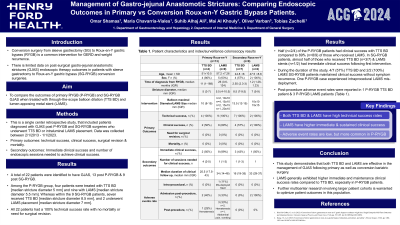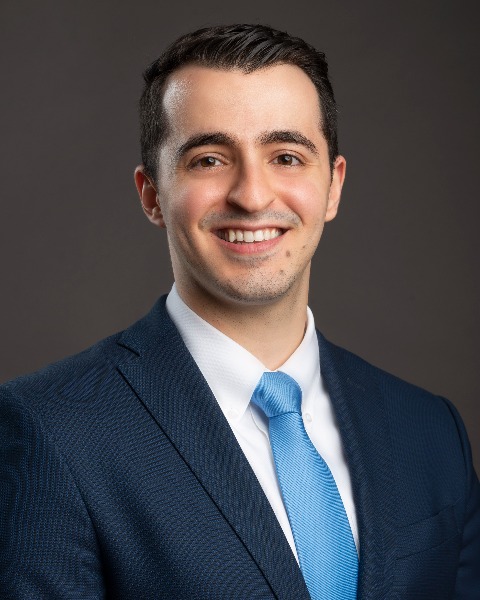Sunday Poster Session
Category: Interventional Endoscopy
P1060 - Management of Gastro-Jejunal Anastomotic Strictures: Comparing Endoscopic Outcomes in Primary vs Conversion Roux-en-Y Gastric Bypass Patients
Sunday, October 27, 2024
3:30 PM - 7:00 PM ET
Location: Exhibit Hall E

Has Audio

Omar Shamaa, MD
Henry Ford Health
Detroit, MI
Presenting Author(s)
Omar Shamaa, MD1, Maria Chavarria-Viales, 1, Suhib Alhaj Ali, MD2, Mai Al Khouly, MBBS1, Oliver Varban, MD1, Tobias Zuchelli, MD2
1Henry Ford Health, Detroit, MI; 2Henry Ford Hospital, Detroit, MI
Introduction: Conversion surgery from sleeve gastrectomy (SG) to Roux-en-Y gastric bypass (RYGB) is a common intervention for GERD and weight recurrence. There is limited data on post-surgical gastro-jejunal anastomotic strictures (GJAS) endoscopic therapy outcomes in patients with sleeve gastrectomy to Roux-en-Y gastric bypass (SG-RYGB) conversion surgeries. Our study aims to compare the outcomes of primary RYGB (P-RYGB) and SG-RYGB GJAS when treated with through-the-scope balloon dilation (TTS BD) and lumen-apposing metal stent (LAMS).
Methods: This is a single center retrospective study, that included patients diagnosed with GJAS post P-RYGB and SG-RYGB surgeries who underwent TTS BD or intraluminal LAMS placement. Data was collected between 2/1/2013 - 1/1/2023. Primary outcomes were technical success, clinical success, surgical revision & mortality. Secondary outcomes included immediate clinical success and the number of endoscopic sessions needed to achieve clinical success.
Results: A total of 22 patients were identified to have GJAS, 13 post P-RYGB (age 55 ±7) & 9 post SG-RYGB (age 45.5 ±6). Among the P-RYGB group, four patients were treated with TTS BD (median stricture diameter 5 mm) and nine with LAMS (median stricture diameter 5.5 mm). Whereas within the 9 SG-RYGB patients, seven received TTS BD (median stricture diameter 8.5 mm), and 2 underwent LAMS placement (median stricture diameter 7 mm). All 22 patients had a 100% technical success rate with no mortality or need for surgical revision. Half (n=2/4) of the P-RYGB patients had clinical success with TTS BD compared to 89% (n=8/9) of those who received LAMS. In SG-RYGB patients, almost half of those who received TTS BD (n=3/7) & LAMS stents (n=1/2) had immediate clinical success following first intervention. During the duration of the study, 4/7 (57%) TTS BD and 2/2 (100%) LAMS SG-RYGB patients maintained clinical success without symptom recurrence. One P-RYGB case experienced intraprocedural LAMS mis-deployment. Post-procedure adverse event rates were reported in 1 P-RYGB TTS BD patient & 3 P-RYGB LAMS patients (Table 1).
Discussion: This study demonstrates that both TTS BD and LAMS are effective in the management of GJAS following primary as well as conversion bariatric surgery. LAMS generally exhibited higher immediate and maintenance clinical success rates compared to TTS BD, especially in P-RYGB patients. Further multicenter research involving larger patient cohorts is warranted to optimize patient outcomes in this population.
Note: The table for this abstract can be viewed in the ePoster Gallery section of the ACG 2024 ePoster Site or in The American Journal of Gastroenterology's abstract supplement issue, both of which will be available starting October 27, 2024.
Disclosures:
Omar Shamaa, MD1, Maria Chavarria-Viales, 1, Suhib Alhaj Ali, MD2, Mai Al Khouly, MBBS1, Oliver Varban, MD1, Tobias Zuchelli, MD2. P1060 - Management of Gastro-Jejunal Anastomotic Strictures: Comparing Endoscopic Outcomes in Primary vs Conversion Roux-en-Y Gastric Bypass Patients, ACG 2024 Annual Scientific Meeting Abstracts. Philadelphia, PA: American College of Gastroenterology.
1Henry Ford Health, Detroit, MI; 2Henry Ford Hospital, Detroit, MI
Introduction: Conversion surgery from sleeve gastrectomy (SG) to Roux-en-Y gastric bypass (RYGB) is a common intervention for GERD and weight recurrence. There is limited data on post-surgical gastro-jejunal anastomotic strictures (GJAS) endoscopic therapy outcomes in patients with sleeve gastrectomy to Roux-en-Y gastric bypass (SG-RYGB) conversion surgeries. Our study aims to compare the outcomes of primary RYGB (P-RYGB) and SG-RYGB GJAS when treated with through-the-scope balloon dilation (TTS BD) and lumen-apposing metal stent (LAMS).
Methods: This is a single center retrospective study, that included patients diagnosed with GJAS post P-RYGB and SG-RYGB surgeries who underwent TTS BD or intraluminal LAMS placement. Data was collected between 2/1/2013 - 1/1/2023. Primary outcomes were technical success, clinical success, surgical revision & mortality. Secondary outcomes included immediate clinical success and the number of endoscopic sessions needed to achieve clinical success.
Results: A total of 22 patients were identified to have GJAS, 13 post P-RYGB (age 55 ±7) & 9 post SG-RYGB (age 45.5 ±6). Among the P-RYGB group, four patients were treated with TTS BD (median stricture diameter 5 mm) and nine with LAMS (median stricture diameter 5.5 mm). Whereas within the 9 SG-RYGB patients, seven received TTS BD (median stricture diameter 8.5 mm), and 2 underwent LAMS placement (median stricture diameter 7 mm). All 22 patients had a 100% technical success rate with no mortality or need for surgical revision. Half (n=2/4) of the P-RYGB patients had clinical success with TTS BD compared to 89% (n=8/9) of those who received LAMS. In SG-RYGB patients, almost half of those who received TTS BD (n=3/7) & LAMS stents (n=1/2) had immediate clinical success following first intervention. During the duration of the study, 4/7 (57%) TTS BD and 2/2 (100%) LAMS SG-RYGB patients maintained clinical success without symptom recurrence. One P-RYGB case experienced intraprocedural LAMS mis-deployment. Post-procedure adverse event rates were reported in 1 P-RYGB TTS BD patient & 3 P-RYGB LAMS patients (Table 1).
Discussion: This study demonstrates that both TTS BD and LAMS are effective in the management of GJAS following primary as well as conversion bariatric surgery. LAMS generally exhibited higher immediate and maintenance clinical success rates compared to TTS BD, especially in P-RYGB patients. Further multicenter research involving larger patient cohorts is warranted to optimize patient outcomes in this population.
Note: The table for this abstract can be viewed in the ePoster Gallery section of the ACG 2024 ePoster Site or in The American Journal of Gastroenterology's abstract supplement issue, both of which will be available starting October 27, 2024.
Disclosures:
Omar Shamaa indicated no relevant financial relationships.
Maria Chavarria-Viales indicated no relevant financial relationships.
Suhib Alhaj Ali indicated no relevant financial relationships.
Mai Al Khouly indicated no relevant financial relationships.
Oliver Varban indicated no relevant financial relationships.
Tobias Zuchelli: Boston Scientific – Consultant.
Omar Shamaa, MD1, Maria Chavarria-Viales, 1, Suhib Alhaj Ali, MD2, Mai Al Khouly, MBBS1, Oliver Varban, MD1, Tobias Zuchelli, MD2. P1060 - Management of Gastro-Jejunal Anastomotic Strictures: Comparing Endoscopic Outcomes in Primary vs Conversion Roux-en-Y Gastric Bypass Patients, ACG 2024 Annual Scientific Meeting Abstracts. Philadelphia, PA: American College of Gastroenterology.
